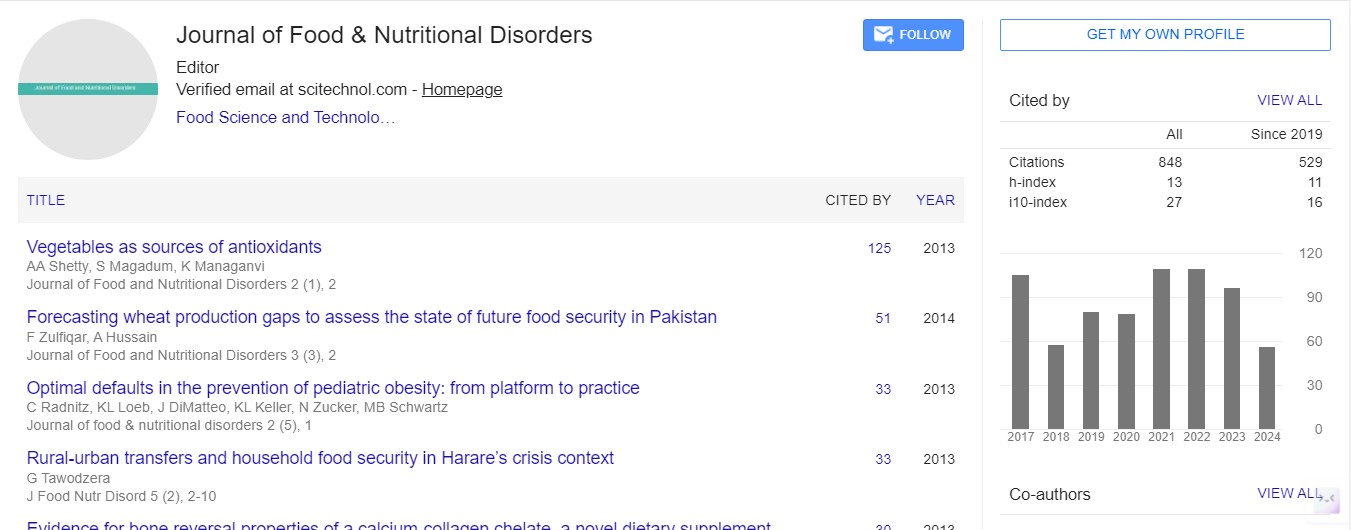Metabolic profile of individuals with obesity according to Edmonton Obesity Staging System
Adryana Cordeiro
University of Porto, Portugal and Federal University of Rio de Janeiro, Brazil
: J Food Nutr Disor
Abstract
Statement of the Problem: Worldwide, obesity is considered a major public health problem (1). In the last four decades, its prevalence has tripled, currently affecting more than 650 million individuals, about 13% of the world population (2). Considered one of the major risk factors for chronic noncommunicable diseases. The most used classifications of obesity are based on the calculation of the Body Mass Index (BMI) or waist circumference (WC) (3). However, excess body weight, by itself, does not necessarily convey the real scene of the health of individuals, with the presence of possible metabolic alterations, as Insulin resistance (IR), Metabolic Syndrome (MS), cardiovascular diseases, arterial hypertension (AH), dyslipidemias and presence of liver steatosis (4). Individuals with the same BMI may have completely different health conditions. Given these limitations of the obesity classification parameters used so far Edmonton Obesity Staging System (EOSS) is a 5-stage obesity classification system that considers metabolic, physical, and psychological parameters to optimize the treatment of obesity (5). Methodology: a descriptive cross-sectional study which the aim was to apply the EOSS classification in individuals with extreme obesity and to evaluate the metabolic profile according to the stages of EOSS. The study was carried out with individuals in the preoperative period of bariatric surgery, of both sexes, age 21-59 years (n = 232). Metabolic parameters were evaluated. Individuals were categorized according to the stages of EOSS, as: stages 0, 1, 2, 3 and 4. Findings: The sample had an average age of 45.1 ± 19.6 years and was composed of 76.6% (178) women. The categorization by stages of EOSS was 1.7% (4), 21.6% (50), 62.5% (145), 14.2% (33), in stages 0, 1, 2 and 3, respectively. Individuals were not categorized in stage 4. High prevalence of IR, AH, MS, hypertriglyceridemia, hypercholesterolemia, and hyperuricemia were observed in stage 2 of EOSS (65.2%, 81.7%, 75.2, 86.0%, 64.0% and 55.3%), respectively. Conclusion: in individuals with extreme obesity, a high prevalence of metabolic alterations was already observed in stage 2 of the EOSS classification.
Biography
Adryana Cordeiro is a nutritionist clinic, PhD/MSc in Medical Science/Faculty of Medicine/University Federal of Rio de Janeiro (UFRJ), Scientific Researcher/Unit of Biochemistry/Biomedicine Departament/Faculty of Medicine/University of Porto – Portugal, Researcher of Micronutrients Research Center/Institute of Nutrition/ UFRJ, Scientific Researcher of Pos-doctorate/ Institute of Nutrition/UFRJ. She is a writer of many manuscripts and chapters books about obesity, vitamin D nutritional status, nutritional deficiencies and metabolic diseases (cardiovascular disease, metabolic syndrome, metabolic-associated fatty liver disease).
 Spanish
Spanish  Chinese
Chinese  Russian
Russian  German
German  French
French  Japanese
Japanese  Portuguese
Portuguese  Hindi
Hindi 
